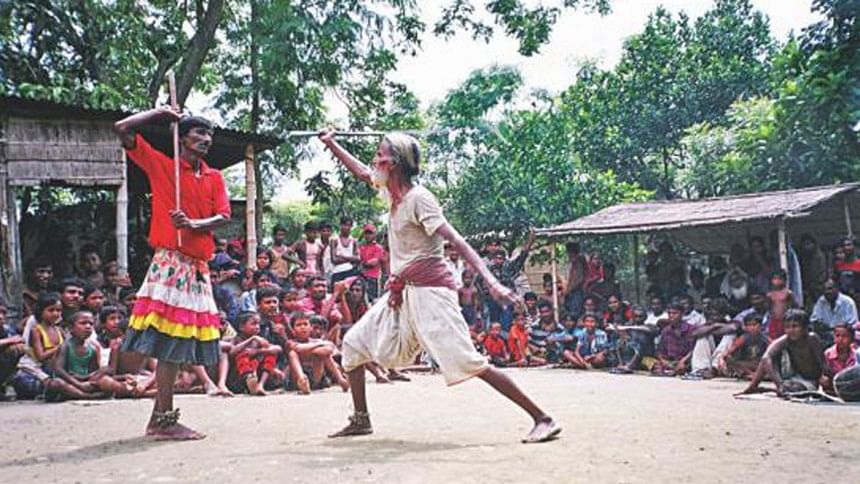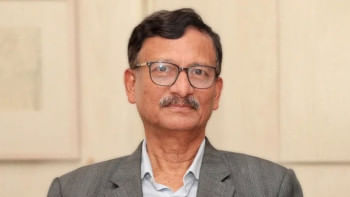Empowering communities through culture

This cross-religious invocation stands as testimony to the inherent pluralism of this deltaic region, which is not just a confluence of rivers from the east, the west, and the north, but also a land that has witnessed the convergence of belief systems from far and wide. These are age-old practices that are well-documented and corroborated. In 1917, Rai Saheb Dineshchandra Sen, in his "Lectures delivered to the Calcutta University" asserts, "Songs of Manasa Devi are sung by professional Muhammadan minstrels in Mymensingh and other districts [of Eastern Bengal]."
Unfortunately, we cannot deny the fact that culture is now a primary "site for struggle", with plurality, as mentioned above, and cultural diversity coming under the two-pronged threat of fundamentalist forces and the "market" operated by transnational capital. These threats are a matter of urgent concern. From our history, we know that the State is a cultural construct. Any threat to culture adversely effects cultural attributes like tolerance, plurality, etc. which inform and help to achieve a State's goals of social progress, national unity, and diversity. Under these circumstances, safeguarding culture is of utmost importance.
To Bangladesh's credit, our Constitution provides sufficient mechanisms for the preservation of culture. Article 23 states that "the State shall adopt measures to conserve the people's cultural traditions and heritage", while Article 23A says that "the State shall take steps to protect and develop the unique local culture and tradition of the tribes, minor races, ethnic sects, and communities". Additionally, Bangladesh is a party to the "UNESCO Convention for Safeguarding of Intangible Cultural Heritage (ICH) 2003", signed by our State in 2009. The convention encourages Member States to safeguard ICH practices with the aim of empowering communities. The convention also provides guidelines for integrating ICH safeguarding processes with the "action and delivery" efforts to achieve Sustainable Development Goals (SDGs) of 2030.
The truth though is that in spite of the infrastructure for safeguarding communities being in place, Bangladesh is far away from the practical implementation of the tenets of the ICH Convention. Truly, there are many slips between the cup and the lip, especially if the hand which holds the cup is both unaware and unwilling.
The first stipulation of the 2003 ICH Convention is that signatory States, as an initial measure, must prepare an inventory of all ICH practices inside their territories within two years of signing the Convention. In 12 years, Bangladesh has failed miserably to do so, in spite of a generous capacity-building donation of USD 200,000—from the government of Azerbaijan in 2016.
The next requirement is the recognition of specific cultural contexts—what may be termed as the "cultural localisation" —of the SDGs. This involves translating the universal language of the SDGs into the individual and collective lives of citizens inhabiting specific communities, cities and regions. To achieve this, a comprehensive understanding of "cultural knowledge and resources" as enablers of sustainable development is required to facilitate a much-awaited overhaul of our 2006 National Cultural Policy.
Given the technical proficiency necessary to accomplish the above requirements of the Convention, UNESCO encourages the State to collaborate with professionals, academics and community members for its enactment. To this end, UNESCO has accredited NGOs in various countries to work hand in hand with the State for the successful implementation of the Convention.
Fortunately, Shadhona—a Centre for Advancement of South Asian Culture, the only UNESCO ICH Committee accredited NGO in Bangladesh—has an impressive decade-long history of safeguarding ICH practices. This includes revitalisation of Lathikhela, Bangladesh's very own martial art; support of the ritual performances of Manasamangal; and conducting Manipuri dance training for the Manipuri communities in Srimangal. In 2018, Shadhona, at the request of the Dhaka Office of UNESCO, did not just prepare an "Assessment Report" on Bangladesh's inability to prepare an inventory of ICH practices, but it also went ahead and constructed an online, digital inventory in the format of an ICH-pedia. In the next two years, inexplicable bureaucratic constraints have prevented the various agencies of the Ministry of Cultural Affairs from accepting Shadhona's offer of support. Finally, in June 2020, the NGO initiated the formation of an informal, multi-organisation consortium, for inventorying all ICH practices of Bangladesh with the support of young students and academics, which it hopes to inaugurate on March 26, 2021, which will be the 50th Independence Day of Bangladesh. Most importantly, the ICH-pedia will be made entirely by the various communities, and with their full consent. To this end, the consortium has trained around 1,000 community members, students, academics, and cultural activists to work on the ICH-pedia. It now appeals to the public to join this participatory process of inventorying ICH practices within Bangladesh.
Cultural practices convey forms of expression, creativity and identity-building that relate to the core of human dignity, and as such embody people-centred, sustainable development. The consortium firmly believes that respect for diverse cultural practices of all indigenous communities makes a nation liberal and compassionate, giving it the ideal groundwork to grow from strength to strength.
Lubna Marium is Artistic Director, Shadhona.

 For all latest news, follow The Daily Star's Google News channel.
For all latest news, follow The Daily Star's Google News channel. 



Comments